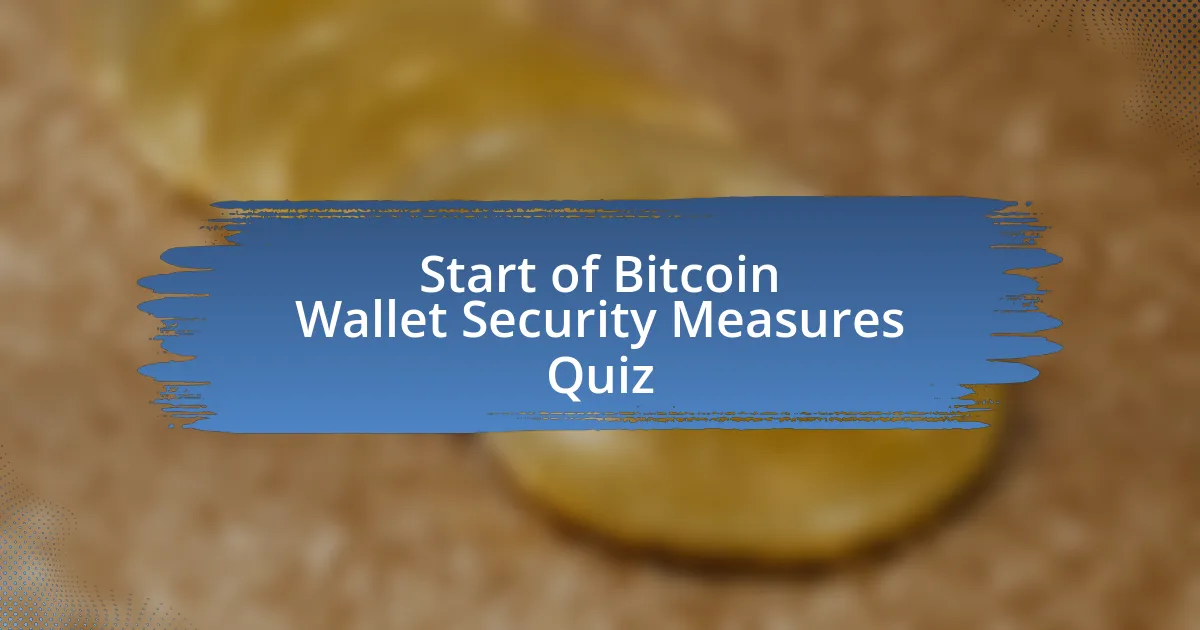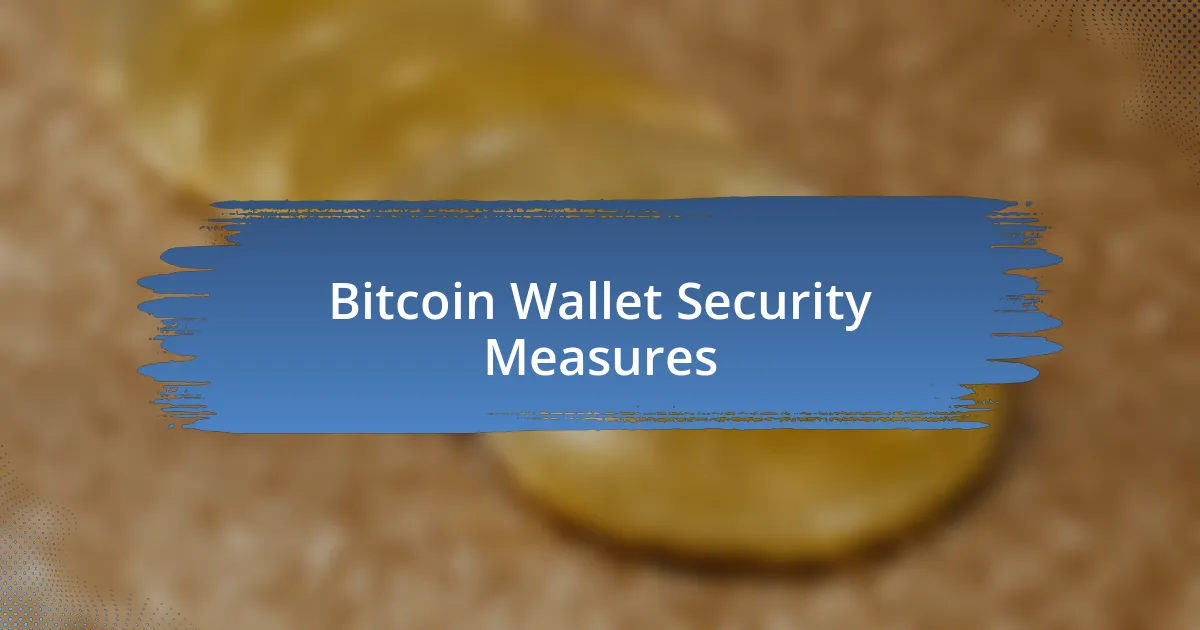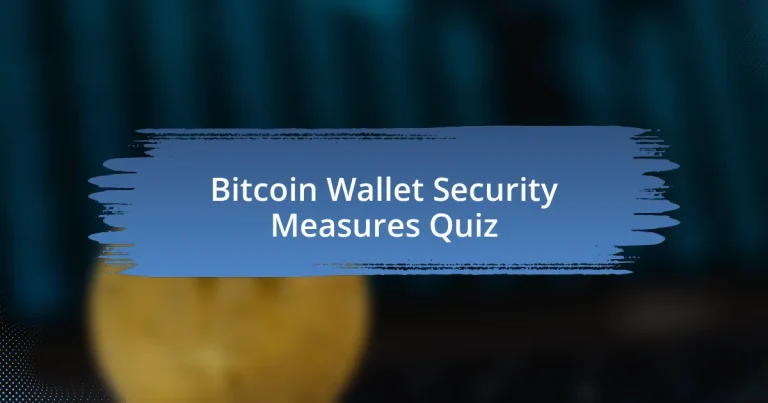
Start of Bitcoin Wallet Security Measures Quiz
1. What is the primary purpose of using a secure, offline environment to generate paper wallets?
- To enhance security by preventing unauthorized access and data tampering.
- To guarantee fast transactions and instant access.
- To facilitate easy trading of cryptocurrencies.
- To simplify the wallet creation process for users.
2. What is a common threat to crypto wallets that involves intercepting communication between the wallet and the server?
- Man-in-the-Middle (MitM) attacks
- Ransomware attacks
- DDoS attacks
- Phishing scams
3. How can MitM attacks be mitigated?
- By using TLS/SSL encryption and implementing certificate pinning.
- By storing passwords in plain text on the device.
- By only relying on user awareness and training.
- By using simple passwords and avoiding encryption.
4. What is TLS/SSL encryption used for in crypto wallet security?
- To encrypt all communications between the wallet and the server, ensuring data is secure in transit.
- To authenticate users via biometric scanning for wallet access.
- To improve user interface design for wallet applications.
- To secure the physical storage of private keys within the device.
5. What is certificate pinning used for in crypto wallet security?
- To store user credentials securely within the application itself.
- To ensure the app communicates only with trusted servers, preventing interception.
- To enhance transaction speeds by shortening connection times.
- To allow multiple users to access the wallet simultaneously without risk.
6. What is the purpose of using a VPN when accessing a crypto wallet over public or untrusted networks?
- To improve transaction speeds and process payments faster.
- To secure further communications by encrypting data transmitted over public networks.
- To allow anonymous trading without any legal implications.
- To limit access to the wallet to a specific geographic area.
7. How can physical theft or loss of crypto wallet devices be mitigated?
- By using Hardware Security Modules (HSMs) or secure elements for key storage and implementing biometric authentication.
- By disabling all security features for simplicity.
- By sharing wallet credentials with trusted friends for backup.
- By storing all keys in a single online location for easy access.
8. What is the purpose of enabling remote wipe capabilities in crypto wallets?
- To synchronize wallet data across multiple devices seamlessly.
- To erase wallet data if a device is lost or stolen, preventing unauthorized access.
- To store wallet data on a secure server for better accessibility.
- To back up wallet data automatically in the cloud for easy recovery.
9. What encryption algorithm is used to encrypt private keys in Bitcoin wallets?
- DES
- Blowfish
- RSA-2048
- AES-256-CBC
10. How are private keys encrypted in Bitcoin wallets?
- The keys are encrypted with a simple substitution cipher for minimal security.
- The keys are encrypted with a master key which is derived from a passphrase and then secured with AES-256-CBC.
- The keys are encrypted directly in plaintext for ease of use in transactions.
- The keys are encrypted using an MD5 hashing algorithm for quick access and retrieval.
11. What happens when a Bitcoin wallet is locked?
- User transactions will be processed without any restrictions.
- The wallet will immediately delete all its contents.
- The wallet will automatically send funds to a default address.
- Calls to `sendtoaddress`, `sendfrom`, `sendmany`, and `keypoolrefill` will return an error requiring the wallet passphrase.
12. What happens when a Bitcoin wallet is unlocked?
- The wallet will automatically delete all data.
- All assets in the wallet are instantly frozen.
- The wallet becomes inaccessible for transactions.
- Transactions can be completed without errors.
13. Why is it important to make a new backup of your Bitcoin wallet when enabling wallet passphrase encryption?
- To allow for unlimited transactions without fees.
- To enhance graphics for better user experience.
- To recover keys from the new key pool in case access to backups is necessary.
- To reduce the wallet size and improve transaction speed.
14. What is the purpose of using a strong passphrase in Bitcoin wallet encryption?
- To keep the wallet accessible even when compromised by attackers.
- To protect the master key and ensure secure access to the wallet.
- To allow easier access for unauthorized users without hindrance.
- To enable faster transactions by simplifying security protocols.
15. What happens if the passphrase is rarely entered in a Bitcoin wallet?
- The wallet will automatically back itself up and become more secure.
- The wallet will send a notification to the user about low activity.
- The keypool might run out, and the default key will be used for payouts, potentially leading to errors in `getnewaddress` and `getaccount` calls.
- The wallet will lock itself for security purposes after many failed attempts.
16. How is the keypool refilled in a Bitcoin wallet?
- The keypool is refilled by sending newly mined coins to the wallet.
- The keypool is automatically refilled when `walletpassphrase` is called with a correct passphrase and when `topupkeypool` is called.
- The keypool is refilled each time the wallet is closed and reopened.
- The keypool is refilled through regular software updates of the wallet application.
17. What is the significance of flushing unused keys from the keypool when enabling wallet passphrase encryption?
- To initiate automatic backups of the wallet data.
- To allow easier access to all keys in the wallet.
- To add new keys protected with encryption and prevent unauthorized access.
- To delete old transactions and free up storage space.
18. What is the difference between custodial and non-custodial wallets in terms of security?
- Custodial wallets allow anonymous transactions, making them safer for users.
- Non-custodial wallets give users full control over their private keys, while custodial wallets hold the keys on behalf of the user.
- Non-custodial wallets link bank accounts to provide additional security layers.
- Custodial wallets are always more secure because they manage all keys for users.
19. What is two-factor authentication (2FA) in crypto wallet security?
- An extra layer of security requiring users to provide two forms of identification before accessing their crypto wallets.
- A process to create backup copies of crypto wallet data online.
- A technique to recover lost passwords using security questions.
- A method for storing cryptocurrencies on a centralized exchange.
20. How does two-factor authentication add security to crypto wallets?
- It adds a second layer of defense against unauthorized access by requiring a time-sensitive code in addition to a password.
- It automatically backs up wallet data to a remote server for recovery purposes.
- It limits access by allowing only one device to connect to the wallet at a time.
- It encrypts the wallet files with a unique password and hides them from the user.
21. What is a multi-signature wallet in crypto security?
- A wallet that requires more than one private key to authorize transactions, ensuring no single party has complete control over the funds.
- A wallet that can hold cryptocurrencies from multiple exchanges without any private keys.
- A wallet that automatically converts all assets to a single currency before transactions occur.
- A wallet that allows transactions without any password or authorization process.
22. How does a multi-signature wallet enhance security?
- It allows single-key access to all wallet features for ease of use.
- It requires bank verification for all transactions being made.
- It reduces the risk of unauthorized access by requiring multiple keys to be compromised simultaneously.
- It eliminates the need for passwords completely for transactions.
23. What is the benefit of using a multi-signature wallet with two out of three keys?
- It minimizes the need for backups by storing all keys in one place.
- It ensures that an attacker would need to compromise multiple keys simultaneously to gain control of the assets.
- It allows for faster transactions by reducing confirmation times.
- It enhances privacy by hiding transaction details from the blockchain.
24. What is the primary encryption algorithm used by Bitcoin Core for wallet encryption?
- DES
- RSA
- Blowfish
- AES
25. Why is AES considered secure for encrypting Bitcoin wallets?
- Because it is the same encryption algorithm used by the NSA for its classified information and is considered extremely secure.
- Because it operates on a simple principle that requires no complex calculations.
- Because it is a proprietary algorithm only used by Bitcoin developers for added secrecy.
- Because it is an outdated algorithm that has never been broken.
26. What is the purpose of hashing in Bitcoin’s Proof-of-Work mechanism?
- To encrypt wallet data ensuring user privacy.
- To store transaction records securely on the blockchain.
- To implement the Proof-of-Work mechanism by requiring miners to find a valid hash below a certain threshold.
- To create digital signatures for transaction verification.
27. What is the significance of SHA-256 in Bitcoin’s hashing operations?
- It is used for all hashing operations in Bitcoin, ensuring the immutability of transactions by constructing a Merkle tree.
- It is the primary encryption method for securing Bitcoin wallets against unauthorized access.
- It serves as a unique identifier for every Bitcoin transaction made by users.
- It is only used during the creation of new Bitcoin blocks in the network.
28. How does the Merkle tree ensure immutability in Bitcoin?
- By calculating a single hash of all transactions in a block, ensuring that every transaction is immutable once included in a block.
- By storing all transaction data in an unencrypted database for quick access.
- By allowing users to edit transactions easily before confirming them in a block.
- By periodically deleting old transactions to save space in the blockchain.
29. What is the purpose of digital signatures in Bitcoin transactions?
- To limit the number of transactions a user can perform within a certain period.
- To verify transactions by allowing a private key to sign any type of message, ensuring that only a valid signature from the corresponding private key can unlock it.
- To encrypt the transaction details, making them unreadable to everyone except the sender.
- To create a unique identifier for each transaction that can be traced easily.
30. What is ECDSA in Bitcoin?
- A type of wallet specifically designed for storing Bitcoin securely offline.
- A digital signature algorithm based on elliptic curve cryptography used to sign transactions and send bitcoin.
- A hashing algorithm used for generating addresses and keys in the Bitcoin network.
- A consensus mechanism for validating transactions across the Bitcoin network.

Quiz Successfully Completed!
Congratulations on completing the quiz on Bitcoin Wallet Security Measures! You’ve taken an important step towards safeguarding your digital assets. It’s vital to grasp how to protect your wallet effectively, and this quiz has helped reinforce that knowledge. You may have learned about different types of wallets, essential security practices, and the importance of safeguarding your private keys.
Understanding these security measures is crucial in the ever-evolving world of cryptocurrencies. With the rise of Bitcoin and other digital currencies, being equipped with the right information can make a significant difference. Now that you have tested your knowledge, you are better prepared to make informed decisions regarding your Bitcoin wallet security.
To further expand your understanding, we invite you to check out the next section on this page. It contains in-depth information on Bitcoin wallet security measures that will enhance your knowledge even more. Dive in to explore best practices, tips, and resources that can provide you with a robust foundation for securing your digital wallet effectively.

Bitcoin Wallet Security Measures
Understanding Bitcoin Wallets
Bitcoin wallets are digital tools that store your cryptocurrency. They can be software or hardware-based. Software wallets include mobile and desktop applications, while hardware wallets are physical devices. Each type offers varying levels of security and accessibility. Understanding the differences helps users choose the right wallet for their needs.
Common Security Threats to Bitcoin Wallets
Bitcoin wallets face numerous threats, including hacking, phishing, and malware. Hackers target online wallets for quick access to funds. Phishing involves deceiving users into providing sensitive information. Malware can compromise the security of wallets, allowing unauthorized access. Awareness of these threats is essential for protecting assets.
Best Practices for Securing Bitcoin Wallets
Securing Bitcoin wallets involves several best practices. Use strong, unique passwords and enable two-factor authentication. Regularly update wallet software to patch vulnerabilities. Backup wallet credentials in a secure location. These measures reduce the risk of unauthorized access and loss of funds.
Hardware Wallets vs. Software Wallets: A Security Comparison
Hardware wallets are generally more secure than software wallets. They store private keys offline, making them less susceptible to online attacks. Software wallets, while convenient, are vulnerable to malware and phishing attacks. Users should assess their security needs and choose the appropriate wallet type based on risk tolerance.
Recovering a Bitcoin Wallet: Steps and Precautions
Recovering a Bitcoin wallet involves specific steps to regain access. Users must have a recovery seed or backup key. It is crucial to keep this information secure and private. When restoring, ensure you use reputable software or devices. Following these precautions helps safeguard funds during recovery.
What are the best practices for Bitcoin wallet security measures?
The best practices for Bitcoin wallet security measures include using hardware wallets, enabling two-factor authentication (2FA), regularly updating software, securing private keys, and using strong passwords. Hardware wallets store private keys offline, minimizing exposure to online threats. Two-factor authentication adds an extra layer of security by requiring a second form of verification. Regular updates protect against vulnerabilities. Secured private keys should never be shared, and strong passwords help prevent unauthorized access.
How can users secure their Bitcoin wallets from theft?
Users can secure their Bitcoin wallets from theft by employing a combination of secure wallet types, activating 2FA, keeping software updated, and being cautious with phishing attempts. Using a cold wallet, like a hardware wallet, significantly lowers the risk of online theft. Activating 2FA ensures that even if the password is compromised, access to the wallet remains protected. Regular software updates help fix security flaws, while vigilance against phishing scams can prevent unauthorized access.
Where should users store their Bitcoin private keys for maximum security?
Users should store their Bitcoin private keys in a secure, offline environment, such as a hardware wallet or a paper wallet. Hardware wallets are specifically designed to protect private keys from online attacks by keeping them offline. Paper wallets, which store the keys on physical media, also reduce the risk of hacking. Both methods ensure that private keys are not exposed to the Internet, minimizing vulnerabilities.
When should users back up their Bitcoin wallets?
Users should back up their Bitcoin wallets immediately after setting them up, and consistently thereafter, especially after any transaction or change to the wallet. Backups should be created following significant changes, like software updates or altering wallet configurations. This ensures that users can restore their wallet if it becomes compromised, lost, or corrupted. Having a recent backup is crucial to prevent any loss of funds.
Who is responsible for the security of Bitcoin wallets?
The security of Bitcoin wallets is primarily the responsibility of the wallet owner. Users must implement security measures like strong passwords and 2FA to protect their wallets. While wallet providers offer certain security features, ultimate responsibility lies with the individuals holding the wallets. They must be proactive in safeguarding their assets against potential threats and ensuring their private keys and recovery phrases are secured properly.


